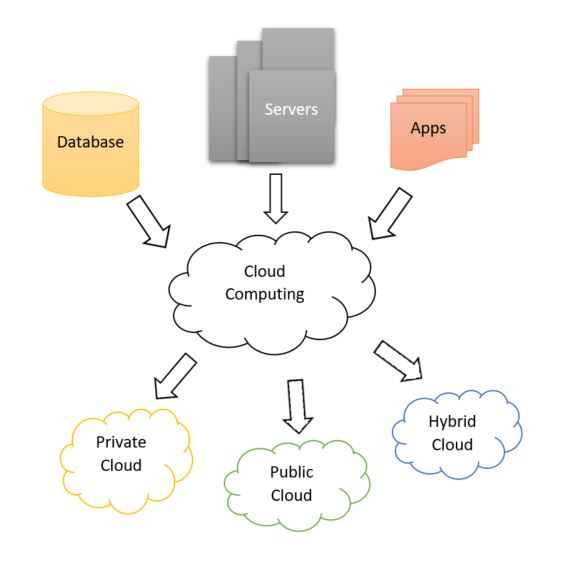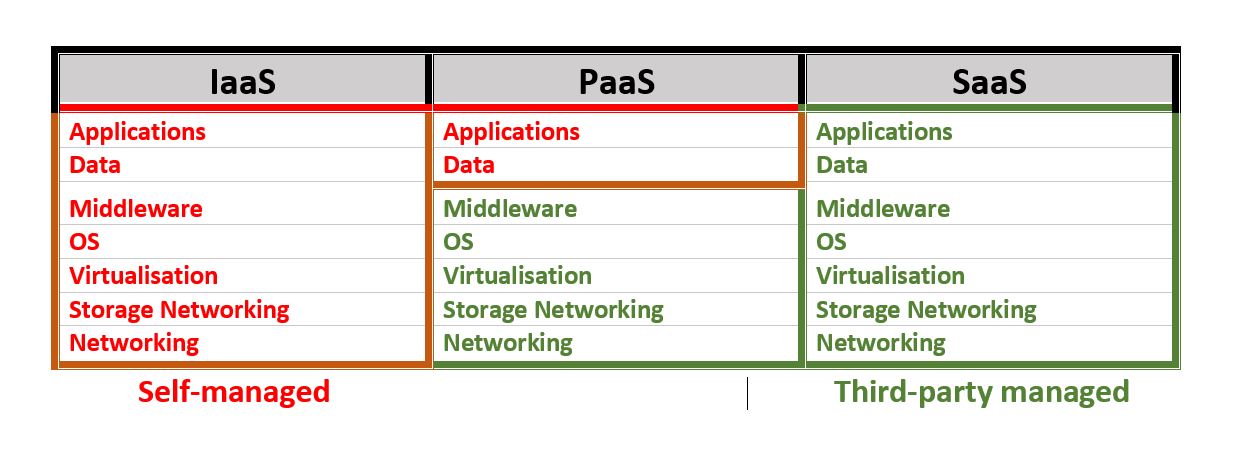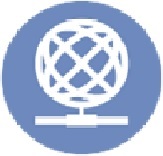Difference between revisions of "Guidance"
| Line 24: | Line 24: | ||
A traditional IT environment for hosting legacy applications that cannot be deployed to a cloud environment | A traditional IT environment for hosting legacy applications that cannot be deployed to a cloud environment | ||
<br> | <br> | ||
| + | == Cloud Benefits == | ||
| + | * Cost effective: IT infrastructure is costly and labor intensive, cloud offers an opportunity to offset these costs. | ||
| + | * Highly flexible and scalable | ||
| + | * Multiuser | ||
| + | * High accessibility from any device anytime | ||
| − | == Cloud | + | == Cloud Computing Service Models == |
| + | The National Institute of Standards and Technology defines 3 cloud service models: | ||
| + | [[File:Iaas.jpg|800px|frameless|center]] | ||
| − | |||
| − | |||
=== IaaS – Infrastructure as a Service === | === IaaS – Infrastructure as a Service === | ||
| − | + | offer services such as pay-as-you-go storage, networking, and virtualization. | |
| + | IaaS gives users cloud-based alternatives to on-premise infrastructure, so businesses can avoid investing in expensive on-site resources. | ||
| + | <br> | ||
=== PaaS – Platform as a Service === | === PaaS – Platform as a Service === | ||
| + | Vendor provides hardware and software tools over the internet, and people use these tools to develop applications. PaaS users tend to be developers. | ||
| + | <br> | ||
=== SaaS – Software as a Service === | === SaaS – Software as a Service === | ||
| + | Platforms make software available to users over the internet, usually for a monthly subscription fee. | ||
<br> | <br> | ||
== GC Cloud adoption principles == | == GC Cloud adoption principles == | ||
Revision as of 23:35, 28 January 2020
Guidance
Overview
The GC Cloud first strategy indicates that when evaluating new IT investments, initiatives, strategies and projects, Departments should consider Cloud options first.
Learn more about the Cloud first strategy by clicking here.
What is the Cloud?
Cloud computing is the delivery of on-demand computing resources (from applications to data centres) over the Internet on a pay-for-use basis
Cloud deployment models
When deploying new solutions Departments should select cloud models in the following order of priority.
Public Cloud
Computing cloud resources are owned and operated by a third-party cloud service provider (CSP).
Hybrid Cloud
Public and private clouds are used with data and applications communicating between the two.
Private Cloud
Computing cloud resources (that can be located on the premises or hosted by a third-party CSP) are dedicated to one organization and maintained on a private network.
Non-Cloud
A traditional IT environment for hosting legacy applications that cannot be deployed to a cloud environment
Cloud Benefits
- Cost effective: IT infrastructure is costly and labor intensive, cloud offers an opportunity to offset these costs.
- Highly flexible and scalable
- Multiuser
- High accessibility from any device anytime
Cloud Computing Service Models
The National Institute of Standards and Technology defines 3 cloud service models:
IaaS – Infrastructure as a Service
offer services such as pay-as-you-go storage, networking, and virtualization.
IaaS gives users cloud-based alternatives to on-premise infrastructure, so businesses can avoid investing in expensive on-site resources.
PaaS – Platform as a Service
Vendor provides hardware and software tools over the internet, and people use these tools to develop applications. PaaS users tend to be developers.
SaaS – Software as a Service
Platforms make software available to users over the internet, usually for a monthly subscription fee.
GC Cloud adoption principles
developed key principles. These principles indent to ensure that GC maximize benefit and at the same time comply with key data security requirements. The principles can be found in Government of Canada Cloud Adoption Strategy.
Cloud Implementation Approach
TBS in collaboration with other departments had developed a 4 phases approach to implementing cloud. The diagram below depicts the approach.
For more information of the implementation approach visit: Implementation Approach
Considering Business Context
four factor which include Business, Information, Application and technology while planning for cloud migration. For more information read GC Government of Canada Right Cloud Selection Guidance.
If you would like to learn more about the Cloud adoption Strategy of the Government of Canada click here or visit our Policy section.









